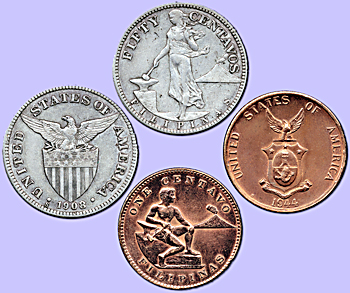U.S. Coins of the Philippines
|
"Making Cents"
The Signal
Saturday, March 19, 2005
| A |
The previously used coinage consisted of colonial coins of the Spanish realm, and various Asian coins. Starting in 1903, coinage included the half centavo and one centavo in bronze; five centavos in nickel; and ten centavos, 20 centavos, 50 centavos and one peso in silver.
The silver coins were larger than the U.S. coins of same era until 1906, when they were reduced to comparable size and weight with U.S. silver coinage.
In 1935, the Commonwealth of the Philippines was established, and in 1937, new coinage was issued. Like the older issues, the new coins still bore "The United States of America" on one side and "Filipinas" on the other.
The new commonwealth issues included one centavo and five centavos in base metal, and 10, 20 and 50 centavos in silver. All were issued from 1937 to 1945 except the 50 centavos, which was issued in 1944 and 1945. The series was minted in Manila, San Francisco, and Denver and bear an "M," "S," or "D" mint mark.
In 1936, a pair of silver commemoratives was issued to honor the commonwealth, featuring Philippine President Manuel L. Quezon and U.S. High Commissioner Frank Murphy. Another silver peso was issued in 1936, also honoring the commonwealth and featuring Quezon and President Franklin D. Roosevelt.
A complete set of U.S. Philippines coinage, including proof issues, consists of 181 pieces — not including two very interesting mint-error "mules," a 1918-S five-centavo obverse with a 20-centavo reverse; and a 1928-M twenty-centavos with a five-centavos reverse.
The most valuable coins in the series are the proofs and low-mintage silver pesos of 1903 through 1912. In mint condition, most of these coins catalogue for a few hundred dollars, with the rare 1906-S listed at $11,000 in mint condition.
Dr. Sol Taylor of Sherman Oaks is president of the Society of Lincoln Cent Collectors and author of The Standard Guide to the Lincoln Cent. Click here for ordering information.
©2005, THE SIGNAL · ALL RIGHTS RESERVED.
